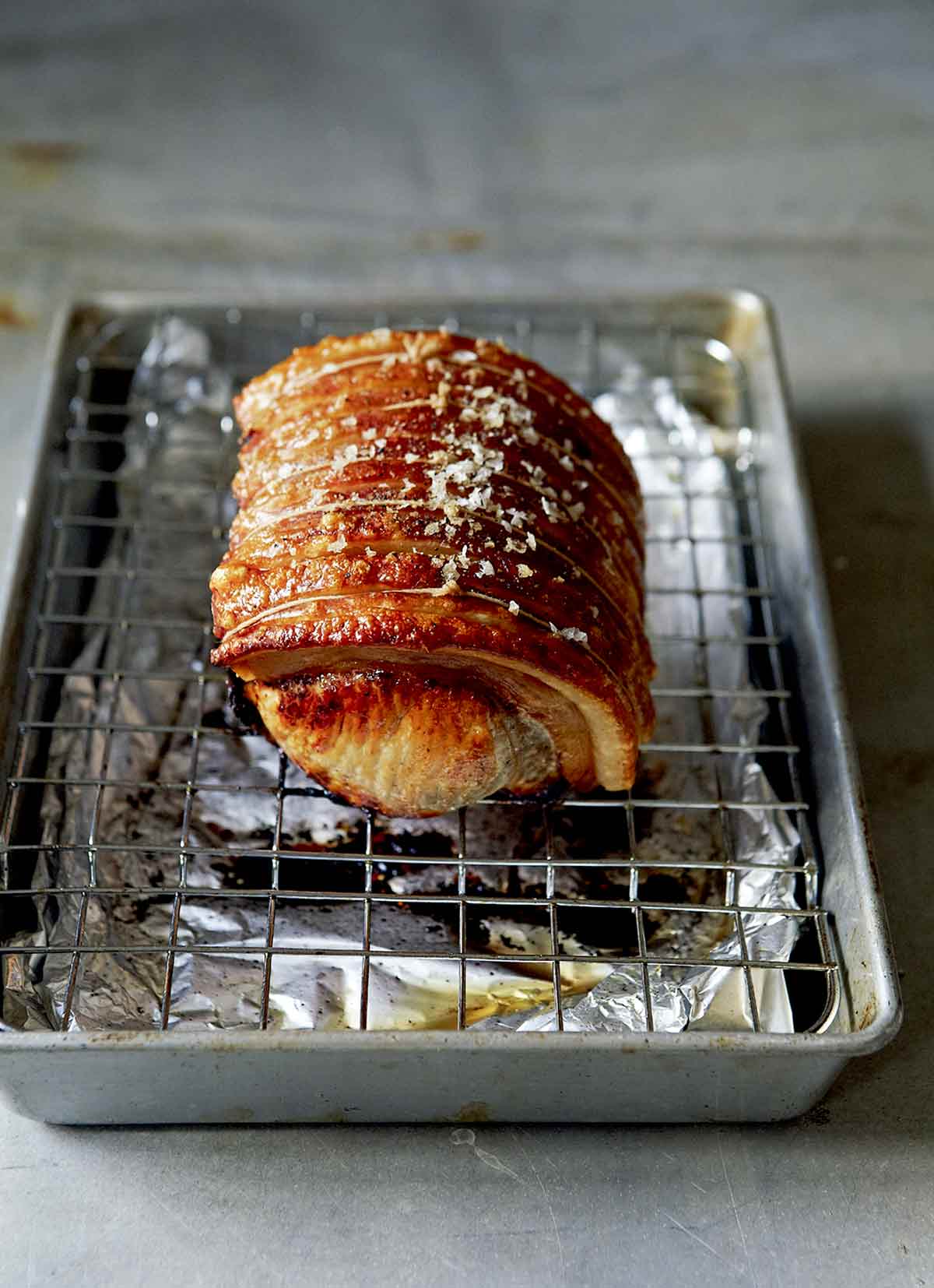Cooking Time Pork Loin Roast

This pork loin roast calls for boneless pork loin, olive oil, salt, and pepper to be slow-roasted. Four ingredients. Incredibly easy to make. No-fuss. And it makes the one of best pork roasts we've ever had.

This boneless pork loin roast is easy and old-fashioned and just like what your grandma would put on the table for Sunday supper. No marinade. No fuss. Just shove it in the oven for its long, slow cooking time while you tend to something else. Then accept accolades on just how incredibly juicy and go-wobbly-in-the-knees flavorful it is.–Renee Schettler
Pork Loin Roast FAQs
How do I keep pork loin from drying out?
The only trick to making roast pork loin–aside, that is, from being patient during its long, slow spell in the oven—is knowing how to keep the pork loin from drying out. The answer lies in the kind of pork loin that your grandma's neighborhood butcher had readily available—meaning one with sufficient fat so the roast essentially bastes itself as the fat melts. It can be tricky to source this sorta thing nowadays. You may have to go to a few butcher counters before you find one that has a nice, thick section of white fat attached. Persist. It's worth the time and effort.
How do I tie a pork loin roast?
If you didn't grow up watching your grandma do this, it's essentially just folding or rolling or tucking the various flappy parts of boneless pork loin into a cylinder that's similarly sized throughout. Then you simply tie and knot it with kitchen string at intervals every few inches. The tying creates structure to help keep all those pesky flappy parts in place. The even size and shape helps ensure that the pork cooks evenly.
Pork Loin Roast

This pork loin roast calls for boneless pork loin, olive oil, salt, and pepper to be slow roasted. Four ingredients. Incredibly easy to make. No fuss. And it makes the one of best roast pork we've ever had.
Johnnie Mountain
Prep 10 mins
Cook 1 hr 15 mins
Total 1 hr 35 mins
-
Kitchen string
- One (2-pound) boneless pork loin roast*, with a generously thick layer of fat and, if possible, with the skin still attached and definitely with a thick layer of fat on the top side tied with string*
- 1 to 2 teaspoons olive oil
- Coarse sea or kosher salt and freshly ground black pepper
-
Preheat the oven to 475°F (250°C). Line a rimmed baking sheet or shallow roasting pan with foil.
-
Pat the pork with paper towels until completely dry. If your pork loin has skin attached, using a sharp knife, score the skin by making deep, long, parallel cuts, 1/8 to 1/4 inch apart, in the fat, being careful not to cut through to the underlying pork.
-
Rub the pork all over with the oil and then sprinkle the top with a generous amount of salt and pepper.
-
Place the pork on a wire rack, skin or fat side up, and place the whole shebang on the baking sheet or in the roasting pan. Roast for 25 minutes. (The initial high temperature promotes crisp crackling, which is the skin.)
-
Reduce the oven temperature to 350°F (180°C) and roast until cooked through, 40 to 45 minutes longer, rotating the pan once halfway through to ensure even cooking. The meat should be slightly pink in the middle. If you have a meat thermometer, it should read 145°F (63°C). You may need to adjust the cooking time, depending on the weight of the pork roast. Rest assured, the pork will continue to cook slightly after it's removed from the oven.
A basic guide when cooking a pork roast is to allow 22 minutes per pound for medium done. If you like your pork more well-done, cook it for 27 minutes per pound.
-
Place the pork roast on a warm platter and let it rest in a warm place for 10 to 20 minutes before carving. Don't cover the roast as any steam coming from the resting pork will soften the skin, which will have crisped into "cracklings." And you don't want to lose that!
If you're the sort who prefers extra-crisp cracklings, while the pork roast is cooling, remove the entire portion of skin from the pork loin, cover the pork loin with foil, and place the skin on the baking sheet or the roasting pan and either crank the oven to 425°F (220°C) and give the cracklings a quick blast under your broiler while the pork rests.
-
To carve the pork roast, remove the skin, if you haven't already done so, and cut the crisp pork skin into strips. Carve the pork roast across the grain into slices, arrange them on a platter, and there you go.
Serving: 1 portion Calories: 308 kcal (15%) Protein: 51 g (102%) Fat: 10 g (15%) Saturated Fat: 3 g (19%) Polyunsaturated Fat: 1 g Monounsaturated Fat: 4 g Cholesterol: 143 mg (48%) Sodium: 111 mg (5%) Potassium: 848 mg (24%) Calcium: 11 mg (1%) Iron: 1 mg (6%)
Recipe Testers' Reviews
Originally published September 23, 2013
Recipe © 2012 Johnnie Mountain. Photo © 2012 Yuki Sugiura. All rights reserved. All materials used with permission.
![]() If you make this recipe, snap a photo and hashtag it #LeitesCulinaria. We'd love to see your creations on Instagram, Facebook, and Twitter.
If you make this recipe, snap a photo and hashtag it #LeitesCulinaria. We'd love to see your creations on Instagram, Facebook, and Twitter.
Cooking Time Pork Loin Roast
Source: https://leitesculinaria.com/87595/recipes-pork-loin-roast.html
Posted by: gossstrable.blogspot.com

0 Response to "Cooking Time Pork Loin Roast"
Post a Comment